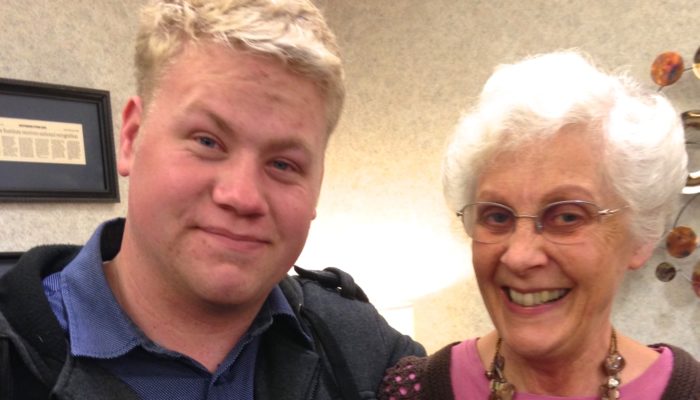
In Childhood Apraxia of Speech, CAS, the brain has difficulty telling the mouth what to do to produce speech sounds. We might say that the messages from the brain get mixed up before they reach the mouth. The child has trouble imitating the precise movements required to say sounds and syllables. Simple words become tongue twisters. It is a unique disorder, which requires intensive speech therapy. In severe cases, fluent, intelligible speech can be difficult to attain. In this article I tell about two boys with CAS and their long roads to effective, intelligible speech.
Arne, a “Severely Speech Impaired” Boy
Many years ago, I was confronted with a challenging case, a boy named Arne. At the time, I was studying educational psychology in Lund, Sweden, with the goal of becoming a speech pathologist. This seven year old boy was hospitalized for assessment at the university hospital.
Though Sweden had a well-developed program for educating children with all different categories of special needs, nobody knew what to do with this little boy. He simply didn’t seem to fit any known category. He wasn’t deaf or hard of hearing. He certainly wasn’t “retarded.” He communicated surprisingly well with gestures and body language, so he obviously was not autistic. He just wasn’t talking.
There was no qualified expert in speech disorders available in the area. So a fellow student and I were given the challenge of trying to figure out what was going on with this boy. Both of us hade extensive studies behind us in phonetics and linguistics. We had also observed various speech therapy sessions, but were still waiting for a clinical program in speech pathology.
Search for a Diagnosis
At that time, I was learning to use non-verbal intelligence tests, so Arne became my subject. The result of the test showed an average IQ. His motor skills were immature for his age. He had difficulty using scissors and still walked down stairs with one foot leading.
We had to use our own ingenuity to assess language skills, because no formal tests were yet available. Arne followed any instructions we could throw at him without the slightest hesitation. There was clearly nothing wrong with his thinking ability or language comprehension. Yet, at seven years of age, he only said about a dozen words, all of which were “baby talk” kinds of words.
Arne was able to get his point across surprisingly well, at least to the person willing to “listen.” I will never forget the day when he with very expressive gestures and his few words told us that he had been up till the early morning hours watching the Olympics on TV. He even told us what competition it was. The games were held in America that year, a considerable time-zone distance away, and some popular competitions were shown in the middle of the night.
Identifying the Diagnosis
At the time, there was no specific diagnosis to fit this boy’s speech disorder, only “severe speech impairment.” It was not until decades later that I realized a relatively newly identified disorder named “Childhood Apraxia of Speech” perfectly fit his speech problem. How could I determine a diagnosis so many years later?
The first four months of working with Arne, we saw him essentially every day. I invested a great deal of interest in this boy and made daily narrative notes, which I still have. I later made him the subject of a thesis, which I also still have. All this information gives me a picture as clear as if it were happening now.
The huge difference between his receptive and expressive ability (understanding and production of speech) was just one of many clues. His great creativity in using gestures to “talk” showed a real desire to communicate. This was a clear sign that we were dealing with true difficulty using speech. The phonetic structure of his few words was in itself a sign of motor programming difficulties. But it is the way he responded to therapy that provides proof of the diagnosis. He tried hard to imitate sounds and syllables but was extremely awkward and inconsistent in his attempts . He was for a long time unable to produce a simple two-syllable word in which either the vowel or the consonant changed. This was in spite of all the sounds being ones he was already using in some words.
Arne’s Progress
We worked hard with this boy for a years and a half. Over this period we managed to get his vocabulary expanded and his pronunciation significantly improved. He was starting to put a few words together into short, grammatically incomplete sentences. I can’t help but wonder how much better our results might have been, had we understood the exact nature of his difficulties. And what if his therapy could have started at age two or three instead of seven?
I never had opportunity to work directly with Arne again. I have, however, been able to follow his progress somewhat over the years. School placement continued to be a problem. He needed therapy and special language instruction throughout his school years. In addition to CAS, a motor programming disorder, he turned out to also have considerable language programming difficulties, i.e. difficulties putting sentences together properly. His sentence structure is still somewhat lacking.
Until a few years ago this “boy,” now around 60 years old, would call me from Sweden once or twice a year. We were able to carry on a conversation, though here and there some part was a bit hard to understand. His writing looked like that of a young child with all capitals, poor punctuation, and some letter reversals. In 1999, I had the opportunity to visit with Arne briefly in Sweden. He was then 45 years old. Here is a picture of me with Arne at that time:
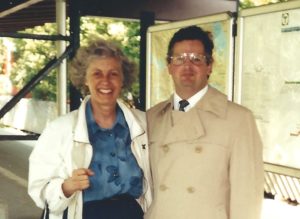
For years I held up this boy in Sweden as the most severe speech problem I had seen throughout my career. As a reassurance to parents I would add, “He is now an adult and talks with me on the phone from time to time.”
But is he still the most severe case I have ever seen? The only one, who might rival Arne as the most severe, is a boy I first saw about 16 years ago.
Logan, a Boy Diagnosed with CAS
In the spring of 2001, a little boy entered the preschool where I was working. He was transitioning from the local early intervention program and thus had been receiving some in-home speech services. His name was Logan, and he was to be turning three a month or so later. His only word was “mama” with any other efforts to verbalize coming out only as “uh-uh-uh.” His parents explained that he hadn’t been hearing for most of his life and that was why he didn’t talk. He now had tubes in his ears, so his hearing was expected to be largely normal.
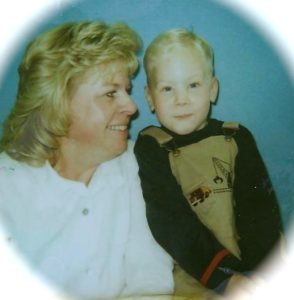
Logan at about the time he first came to preschool.
Initial Therapy
I worked with Logan one-on-one three days a week through the rest of the spring and once or twice a week through most of the summer. We would sit in front of a mirrored wall making faces and imitating each other. I would try to get him to imitate sounds while shaping my mouth for the contrasting vowel sounds “ee,” “aah,” and “oo.” This was fairly successful.
To get Logan to attempt syllables, I introduced a “game” in which we sat on the floor facing each other and sending a car back and forth. The rule of the game was this: to get the car to come back, you had to ask for it with a word. Because he already was using the consonant /m/ in “mama,” I chose the word “(c)ome.” I did not expect the /k/ sound but simply the syllable “um.” This too was fairly successful.
In spite of his lack of verbal communication, Logan was quite a social little boy. When all the children returned for the new school year, he was anxious to take part in whatever the other children were doing. He was not very interested in coming over to my corner of the room to work on imitating sounds and syllables. Capitalizing on his desire to be like the other children, I designed some whole class activities. I would show an object and each child in turn would say something about it, using a given short phrase.
With these simple activities, I got Logan to attempt some words and phrases. It created the needed motivation but was not very productive in expanding his repertoire of sounds and syllables. He needed one-on-one therapy. I pulled him aside for brief, focused sessions. With this combined approach, I expected to build on what had been achieved in the summer. However, results were very slow in coming. It proved difficult to move beyond the vowel sounds in combinations with /m/.
Fluctuating hearing loss due to chronic ear infections is a common cause of delay in speech development. Once the hearing is largely restored through tubes in the eardrums, we tend to see rather rapid progress with speech therapy. When we don’t get the expected progress, there is usually an additional cause contributing to the delay. I had seen this again and again in my professional experience.
Getting the CAS Diagnosis
Logan’s extreme difficulties imitating sounds and sound combinations led me to strongly suspect apraxia as the central problem. Once I was fairly confident in this tentative diagnosis, I mentioned it to his mother. Being a very proactive mother, she immediately began searching the Internet for information. This led her to www.apraxia-kids.org, the official website of CASANA, the Childhood Apraxia of Speech Association of North America.
This contact led to Logan’s mother and I together, over the next few years, attending several workshops and a major conference put on by CASANA. All of these featured Edythe Strand, one of the nation’s leading authorities on Childhood Apraxia of Speech.
Through the contact with Dr. Strand, Logan was given the opportunity to receive a thorough evaluation at the Mayo Clinic in Minnesota. This evaluation supported my diagnosis of Childhood Apraxia of Speech. Logan was also found to have additional language processing difficulties and a continued hearing impairment. Nevertheless, CAS was clearly the central problem causing his speech difficulties. He was able to spend time during several summers receiving expert speech therapy from Dr. Strand and her staff. Through contacts with Dr. Strand, I also learned some new, specific strategies to more effectively help Logan.
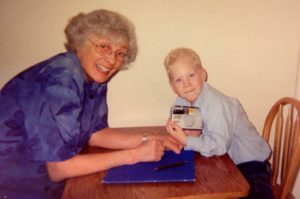
Logan in therapy session ( about Kindergarten)
Continued Progress
After three years in preschool, Logan went on to Kindergarten. He then progressed through the grades until he graduated from high school last spring, 2017. I had the privilege of working with him through his fifth grade, a total of nine years. This is longer than I have worked with any other client throughout my career.
It took many years of intensive practice in therapy sessions before Logan was able to produce intelligible, self-formulated sentences. By first or second grade he had learned to produce a number of useful words and phrases intelligibly. With these, Logan was able to communicate at a basic level. But, by this time he was also attempting to formulate complete sentences on his own. When his learned words and phrases became embedded in longer sentences, the articulation of them broke down. His speech became less intelligible. Here he is with his special education teacher and myself at about third grade:
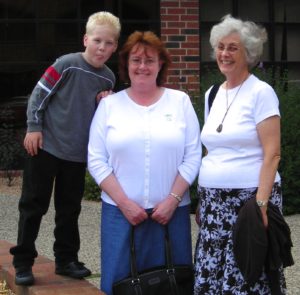
I remember Logan’s parents at this point expressing concern that his speech was not improving but instead getting worse. The breakdown in intelligibility of individual words in connected speech is a hallmark of apraxia. I explained to his parents that the progress at this point was in the ability to formulate longer sentences. The intelligibility would eventually catch up, I assured them.
Logan has now graduated from high school. The following is an excerpt from his mother’s letter of September 2017, posted under Testimonials on this website:
“Logan is now 19 years old and has graduated from High School. He is a verbal communicator. His speech is understood by most people. He would not be where he is today without his amazing team of educators, speech therapists, family and friends and their efforts to help him achieve verbal communication.”
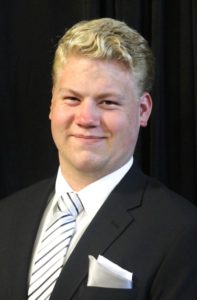
Conclusions
Like any speech disorder, Childhood Apraxia of Speech occurs at all levels of severity. I have seen many children with CAS throughout my career, now spanning five decades. But, none other has been as severe as these two boys. So what can we learn from these two cases?
Perhaps most important for parents is the fact that both in the end became verbal communicators. That is in spite of the severity of the problem. For a long time, they both relied on gestures and sign language to communicate. Eventually they were able to use speech effectively, even though not perfectly. Some people still occasionally have difficulty understanding a word here and there.
The other thing clearly demonstrated in these two cases is the amount of time and effort it took to achieve the success. Logan’s mother, in her letter, emphasized that it took a team of “educators, speech therapists, family and friends.” This is vitally important. It was never just a single person’s effort. And we must not forget the tremendous effort put forth by Logan himself! It was never an easy process for him.
Logan’s story is a great demonstration of what it takes to successfully treat CAS. His therapy started early. Once he received a definitive diagnosis, he was provided with specifically targeted therapy. He also had the benefit of a very proactive family, who followed through with exercises and provided important emotional support.
By comparison, Arne was at a clear disadvantage. He received no services before he was seven years old. Childhood Apraxia of Speech was not yet discovered as a distinct speech disorder. Therefore, no one knew of specially targeted therapy techniques for treating this unique speech problem. In addition, his family support was minimal at best. He got all his schooling in residential schools and thus spent only holidays and summer vacations with his family.
Even though CAS is a very specific and unique speech disorder, it seldom occurs in complete isolation. In my experience, there are usually other associated issues. This was the case with both of these boys. The nature and extent of such issues will certainly affect both the therapy needs and the final outcome.
These are just two cases. No two children are alike. No one can predict the outcome in the individual case. Nevertheless, parents of a child diagnosed with CAS should find encouragement in the outcomes of these two boys. Most other children I have seen with this disorder have reached satisfactory results somewhat faster. Many have in the end achieved completely normal speech.
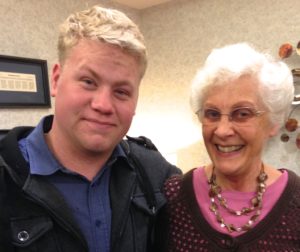
With Logan shortly after his graduation.
(The names and pictures are included in this article by permission.)





Cynthia Wayman
Wow! I’m so excited to see this project come true! I’ll always feel it any honor to have known you, worked with you and learned from you! I truly miss those days!
And, as you know, Logan was my inspiration all through my college years in the field. I love this piece on him, so well told! Informative! And a tear jerker! Yes, l cried!
mychildsspeech
Thank you, Cynthia! You certainly were heavily involved in the work with Logan, first as one of his teachers in the preschool and later as my SLPA. You have had opportunity to follow his gradual progress from nonverbal to the communicative young man he now is. Did you see the article, “Preschool Graduation–a Troubling Announcement”? There I refer to Logan’s milestone accomplishment as he stood up and said his name in front of the audience?